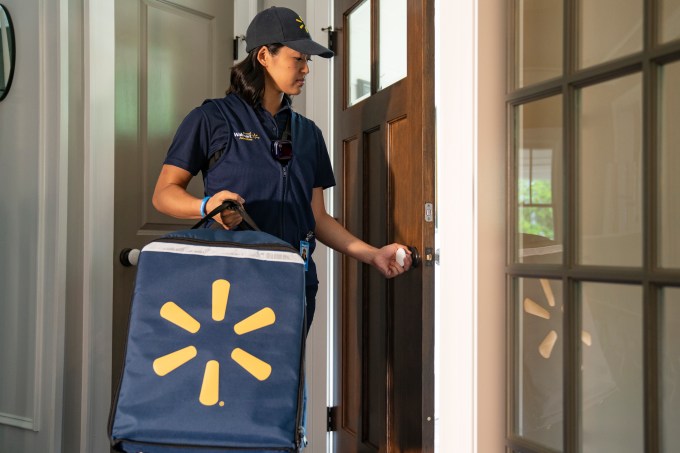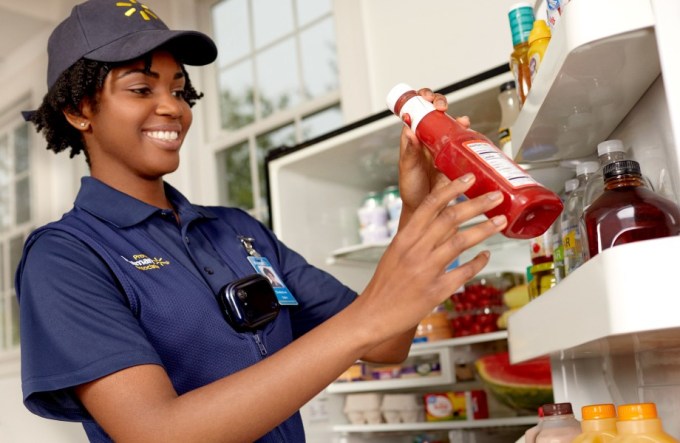Walmart is expanding its service that will deliver your groceries directly to your refrigerator, the company announced today. First launched in fall 2019, Walmart’s InHome delivery service, as it’s called, allows customers to place grocery orders online, then receive their deliveries by having a Walmart associate enter their home by way of a smart lock. The service was initially tested in a small handful of markets, including Kansas City, Pittsburgh and Vero Beach, and is now available to 6 million households across the U.S. after further launches in Northwest Arkansas, Atlanta, Phoenix, and D.C. Today, Walmart says it plans to expand InHome delivery more broadly, with the goal of reaching 30 million U.S. homes by the end of the year.
This will include forthcoming launches in major markets like Dallas, Nashville, L.A., Chicago, Houston, Indianapolis, and others.
As a part of this expansion, Walmart plans to hire more than 3,000 delivery drivers over the course of the year. It will also build out a fleet of 100% all-electric delivery vans which will be used to make the deliveries, while simultaneously marketing the service in the neighborhoods being served.
The InHome service itself is $19.95 per month, which makes it more appropriate for customers who work outside the home during the day or who travel, and want their groceries put away while they’re out.

Image Credits: Walmart
Though it may seem odd to think of having a delivery person enter your home to stock your fridge, the InHome service addresses a major consumer complaint with online grocery delivery — that you have to be at home (or at least be heading home soon) in order to put your cold and frozen groceries away after your order is left at the doorstep.
Services like Shipt and Instacart — top Walmart grocery competitors — don’t offer a solution for keeping customers’ cold items insulated beyond possibly double-bagging items, at the shopper’s discretion. The shoppers for these services only use the paper or plastic bags provided by the store at checkout, and there’s no system for exchanging insulated bags or boxes at the time of delivery or using some sort of insulated cooler at the customer’s home. That means customers will sometimes arrive home to find their ice cream melted or other cold items spoiled, if left out for too long on a hot day. Complicating matters further is that the services don’t always deliver at the time you specified, meaning the deliveries could arrive too early or too late to be convenient.
By offering an in-home service, Walmart can better manage the logistics of delivery on its end, instead of having to work around customers’ demands for specific timeslots throughout the day. Meanwhile, it sells customers on the usefulness of having not just the last mile handled, but also having those last steps covered between doorstep and fridge or kitchen countertop.
“Above all else, convenience is the leading factor for our customers,” Tom Ward, Walmart’s SVP of last-mile delivery, told TechCrunch. “People love to get on doing the things they want to do, and they don’t always want to wait at home for deliveries or whatever it might be…Really, the ultimate convenience is to come home and find all the items you bought waiting for you at home,” he said.

Image Credits: Walmart
InHome customers also appreciate the other perks that come with their subscription, Ward noted.
Subscribers can access all the features of Walmart+, the retailer’s Amazon Prime competitor offering free shipping and more. In addition, InHome customers can leave items they want to return to Walmart on their counter for the InHome delivery driver to take back with them to the store. And this is only the beginning, Ward hinted.
“What we’ve essentially tried to do is think through what are the conveniences would you know customers really want to experience,” he explained. “Rx is going to be on the horizon,” Ward added, referencing Walmart’s plans to integrate its prescription delivery business with InHome, which is already being teased on the InHome website.
When it comes to the delivery process inside the home, the InHome system itself largely works the same as it had at launch.
The system relies on smart lock technology and a video camera worn on the delivery driver’s uniform. Walmart partnered with Level Home for its front door smart entry technology (Level Bolt and Level Touch) and had earlier worked with Nortek Security & Control for its garage door smart entry technology. It’s now offering a retrofit kit for Genie and overhead garage door openers instead.
Walmart customers can select either device for $49.95 or they can now use their existing smart lock or garage keypad as an alternative.
The delivery associate is able to enter the home using a one-time access code provided in their InHome app. The app also notifies the customer the delivery has begun and turns on the camera worn on the associate’s vest. This records the entire delivery which the customer can see as it takes place via their own InHome app. This is meant to eliminate any security concerns around allowing an unknown person into the home when the customer is away. The delivery associate puts the food away while wearing a mask, then sanitizes the surfaces they used and locks up as they leave.

This video recording can be accessed up to a week after each delivery, Walmart notes. But in tests, it’s found that customers begin to trust the process after a few uses — similar to how they may grow to trust other service personnel who are provided with a door code — like a house cleaner or dog walker, for example.
It’s often the same person making the Walmart deliveries, as well, and the company notes it requires a minimum of one year of employment to move up to the new associate delivery driver position.
As the service expands more broadly, Walmart says it’s now formally creating the role of associate delivery driver as a new full-time position that pays an extra $1.50 per hour more than most of its in-store roles. These employees qualify for company benefits like medical, vision, and dental insurance, 401K matching, paid time off, no-cost counseling, and Walmart’s Live Better U program which pays for a free college degree. The retailer says it will initially fill the new positions through internal promotions, and staff will be trained both in-person and using virtual reality experiences through Walmart’s existing VR training platform.
Most of the associate delivery drivers who are already doing this work have an average tenure of over five years with the company, Ward said. Though the promotions to the new position will largely involve existing employees, Walmart expects to fill the positions those employees are vacating — so this expansion will lead to the growth of Walmart’s overall headcount.
“It builds on that track record of more than 300,000 associates who were promoted into roles of greater responsibility and higher pay in FY 21,” Ward noted.
The electric vans used by InHome drivers, meanwhile, advances Walmart’s goal of operating a zero-emissions logistics fleet by 2040 and will be supported by Walmart’s 1,396 EV charging stations at stores and clubs across 41 U.S. states, the company said.
(Walmart is poised to detail its partnership efforts on the EV front in a separate announcement at CES.)
 from eCommerce – TechCrunch https://ift.tt/3sZCR66
from eCommerce – TechCrunch https://ift.tt/3sZCR66 via IFTTT
via IFTTT

No comments:
Post a Comment